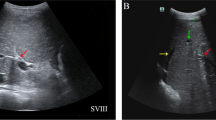Abstract
Herein we present a clinical case of the Caroli syndrome caused by the compound heterozygous mutation in the PKHD1 gene. Histopathological assessment of liver detected biliary cirrhosis, numerous dilated bile ducts of various sizes, hyperplastic cholangiocytes containing a large amount of acid mucopolysaccharides, decreased ß-tubulin expression and increased proliferation of cholangiocytes. A significant proportion of hepatic tissue was composed of giant cysts lined with a single layer of cholangiocytes, containing pus and bile in its lumen and surrounded by granulation tissue. An accumulation of neutrophils in the lumen of the bile ducts was observed, as well as an infiltration of the ducts and cysts surrounding connective tissue by CD4+ and to a lesser extent CD8+ lymphocytes. This may be caused by the expression of HLA-DR by cholangiocytes. Atrophy and desquamation of the epithelium of collecting tubules with the formation of microcysts were detected in the kidneys without a clinically significant loss of renal function. Morphopathogenetic mechanisms of the Caroli syndrome can be targets for a potential pathogenetic therapy and prevention of its manifestations and complications.

Similar content being viewed by others
References
Strazzabosco M, Fabris L. Development of the bile ducts: essentials for the clinical hepatologist. J Hepatol. 2012;56:1159–70.
Kerkar N, Norton K, Suchy FJ. The hepatic fibrocystic diseases. Clin Liver Dis. 2006;10:55–71.
Caroli J, Soupalt R, Kossakowski J, et al. La dilatation polykystique congenitale des voies biliaires intrahepatiques. Essai del classification Sem Hop Paris. 1958;34:488–95.
Richards S, Aziz N, Bale S, et al. Standards and guidelines for the interpretation of sequence variants: a joint consensus recommendation of the american college of medical genetics and genomics and the association for molecular pathology. Genet Med. 2015;17:405–24.
Sharp AM, Messiaen LM, Page G, et al. Comprehensive genomic analysis of PKHD1 mutations in ARPKD cohorts. J Med Genet. 2005;42:336–49.
Ward CJ, Yuan D, Masyuk TV, et al. Cellular and subcellular localization of the ARPKD protein; fibrocystin is expressed on primary cilia. Hum Mol Genet. 2003;12:2703–10.
Li Z, White P, Tuteja G, et al. Foxa1 and Foxa2 regulate bile duct development in mice. J Clin Invest. 2009;119:1537–45.
Fabris L, Strazzabosco M. Epithelial-mesenchymal interactions in biliary diseases. Semin Liver Dis. 2011;31:11–32.
Roskams T, Theise ND, Balabaud C, et al. Nomenclature of the finer branches of the biliary tree: canals, ductules, and ductular reactions in human livers. Hepatology. 2004;39:1739–45.
Omenetti A, Syn WK, Jung Y, et al. Repair-related activation of hedgehog signaling promotes cholangiocyte chemokine production. Hepatology. 2009;50:518–27.
Spirli C, Okolicsanyi S, Fiorotto R, et al. ERK1/2-dependent vascular endothelial growth factor signaling sustains cyst growth in polycystin-2 defective mice. Gastroenterology. 2010;138:360–71.
Nishimoto H, Yamada G, Mizuno M, et al. Immunoelectron microscopic localization of MHC class 1 and 2 antigens on bile duct epithelial cells in patients with primary biliary cirrhosis. Acta Med Okayama. 1994;48:317–22.
Masyuk AI, Gradilone SA, Banales JM, et al. Cholangiocyte primary cilia are chemosensory organelles that detect biliary nucleotides via P2Y12 purinergic receptors. Am J Physiol Gastrointest Liver Physiol. 2008;295:G725-34.
Jang MH, Lee YJ, Kim H. Intrahepatic cholangiocarcinoma arising in Caroli’s disease. Clin Mol Hepatol. 2014;20:402–5.
AbouAlaiwi WA, Ratnam S, Booth RL, et al. Endothelial cells from humans and mice with polycystic kidney disease are characterized by polyploidy and chromosome segregation defects through survivin down-regulation. Hum Mol Genet. 2011;20:354–67.
Sjoblom T, Jones S, Wood LD, et al. The consensus coding sequences of human breast and colorectal cancers. Science. 2006;314:268–74.
Hodgson SV, Coonar AS, Hanson PJ, et al. Two cases of 5q deletions in patients with familial adenomatous polyposis: possible link with Caroli’s disease. J Med Genet. 1993;30:369–75.
Yu TM, Chuang YW, Yu MC, et al. Risk of cancer in patients with polycystic kidney disease: a propensity-score matched analysis of a nationwide, population-based cohort study. Lancet Oncol. 2016;17:1419–25.
Funding
The work is performed according to the Russian Government Program of Competitive Growth of Kazan Federal University.
Author information
Authors and Affiliations
Contributions
Authors MOM, APK and RVD conceived and designed the study, and wrote, edited and reviewed the manuscript. Authors AAT, RRS, MSA, ILP performed histological analysis, and reviewed the manuscript. Authors IMS, NFG, SRA performed clinical examination and reviewed the manuscript. Authors INK, AAI performed genetic analysis and reviewed the manuscript. All authors gave final approval for publication. Author MMO takes full responsibility for the work as a whole, including the study design, access to data and the decision to submit and publish the manuscript.
Corresponding author
Ethics declarations
Conflict of interest
The authors declare that they have no conflict of interest.
Human rights
All procedures followed have been performed in accordance with the ethical standards laid down in the 1964 Declaration of Helsinki and its later amendments.
Informed consent
Consent cannot be obtained because the patient is dead, and the parents/guardian cannot be traced. This study does not contain identifying information of the patients.
Rights and permissions
About this article
Cite this article
Mavlikeev, M., Titova, A., Saitburkhanova, R. et al. Caroli syndrome: a clinical case with detailed histopathological analysis. Clin J Gastroenterol 12, 106–111 (2019). https://doi.org/10.1007/s12328-018-0917-6
Received:
Accepted:
Published:
Issue Date:
DOI: https://doi.org/10.1007/s12328-018-0917-6




